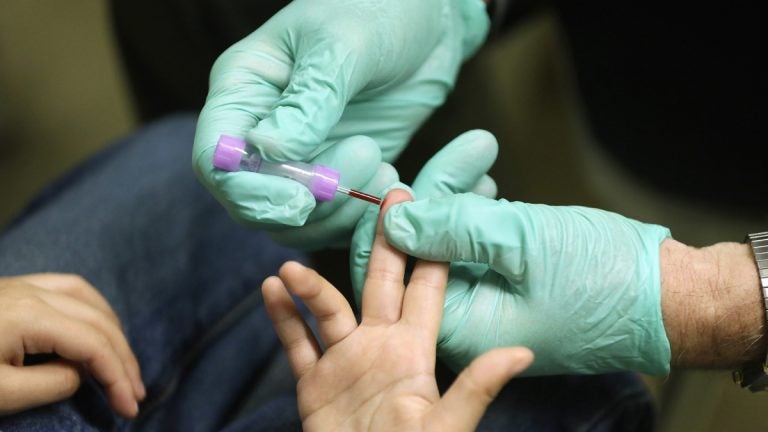New Jersey to test children for lead exposure using tougher CDC standards

A child is tested for lead poisoning. New Jersey lawmakers are considering a constitutional amendment to guarantee a portion of the sales tax on paint sales in the state goes toward its lead abatement efforts. (AP file photo)
New Jersey’s lead-screening standards for children will soon be twice as strong — and tied to federal guidelines in the future — under a law signed by Gov. Chris Christie Monday.
The law requires state lead-poisoning regulations to reflect the recommendations of the Centers for Disease Control and Prevention, which now require additional testing for children found to have more than 5 micrograms of lead per deciliter of blood. Public health experts are pushing to have the federal threshold lowered even further, to 3.5 micrograms/deciliter, and CDC officials tend to update their guidelines every few years.
New Jersey currently considers 10 micrograms/deciliter to be a lead level of “concern” in children six or younger — a threshold state officials have repeatedly defended as safe. But the Department of Health is now in the process of adopting regulations that would reduce this to 5 micrograms/deciliter to reflect the CDC guidance, last updated four years ago, according to a draft published in December.
The law was good news to advocates for the environment, safe housing, and public health, who have worked together over the years to encourage the state to adopt more stringent regulations, guided by CDC scientists. Sponsors of the bill also praised Christie for taking action on the measure (S-1830), which was approved by both legislative houses in December.
“What this new lower lead level means is that more children will likely be identified as having lead exposure, prompting parents, doctors, health officials, and communities to take action earlier to reduce the child’s future exposure to lead,” said Assemblyman Troy Singleton (D-Burlington), one of the bill’s champions.
State officials have said that, in 2015, of the roughly 200,000 children tested, fewer than 900 were found to have blood-lead levels higher than 10 micrograms/deciliter and therefore received additional monitoring, education, and other follow-up. But advocates said that some 3,000 children tested higher than 5 micrograms/deciliter that year. And according to the DOH draft regulations, the state anticipates that using the threshold of 5 micrograms/deciliter going forward could result in an additional 4,000 children being flagged for concern each year.
Lead poisoning became national news in 2015, when dangerously high levels were discovered in the Flint, MI, drinking-water system. Last February, lawmakers in New Jersey held hearings to determine the risk here. Since then, dozens of school systems have tested positive for lead-pollution in their water, but experts agree that the biggest problems for the Garden State are industrial contamination and lead-tainted paint, wires, and other fixtures in old buildings.
Children can be affected by eating paint chips, inhaling lead-tainted dust, or playing with lead-based toys imported from other countries, where use of the heavy metal is less restricted. Lead poisoning can cause serious, lifelong mental and physical complications, and even death. (Experts agree that, while no level of lead is safe, medical intervention is usually not required for children with blood-lead levels of less than 45 micrograms/deciliter.)
“If it can be said that any good has come out of the crisis in Flint, it’s that it reignited the conversation on lead detection and prevention in children nationwide,” said Assemblywoman Nancy Pinkin (D-Middlesex), another sponsor. “This bill turns that conversation into action and demonstrates that we, as a state, are committed to eliminating this threat.”
The law requires rules and regulations issued by the state health department to keep pace with CDC recommendations — a mandate the draft regulations submitted in December would currently satisfy — and to review these every two years to ensure they are still consistent with the federal guidance. It also calls on the DOH to do more to educate providers and the public on the danger of high lead levels. New Jersey is one of 17 states that requires children to be screened.
“We are glad the governor has finally acted on this issue, and made New Jersey’s practice consistent with the best available science,” said Staci Berger, president and chief executive officer of the Housing and Community Development Network of New Jersey. “This is another tool in the toolbox to help us all stop this childhood health epidemic. We should not use children as lead detectors.
Berger and other advocates have also pushed the Christie administration to invest more in lead remediation, particularly in older, low-income communities where there is greater contamination. Critics contend he has diverted between $50 million and $100 million in funds dedicated to lead abatement, and collected through a tax on paint products, for other purposes.
While Christie declined to sign a bill last year that would have reinstated $10 million in funding for lead remediation, his administration has defended its record on addressing the contamination. The state already spends $22 million to provide blood screenings, education, and abatement efforts, his office has said, and in April he provided $10 million to help low-income communities address the toxic threat.
__________________________________________________
NJ Spotlight, an independent online news service on issues critical to New Jersey, makes its in-depth reporting available to NewsWorks.
WHYY is your source for fact-based, in-depth journalism and information. As a nonprofit organization, we rely on financial support from readers like you. Please give today.




